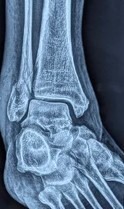Lateral Malleolus Fracture
If you are experiencing lateral malleolus fracture, please Schedule an appointment with one of our orthopedic surgeons as soon as possible.
What is Lateral Malleolus Fracture?
The lateral malleolus is the bony prominence on the outer side of the ankle, formed by the lower end of the fibula. A lateral malleolus fracture occurs when this area of the fibula breaks, often due to trauma or excessive twisting of the ankle. As one of the most common types of ankle fractures, this injury can range from a simple break that heals quickly to a more complex fracture requiring surgery.
Common Causes
A lateral malleolus fracture typically results from:
-
Twisting injuries – Rolling the ankle inward (inversion) during sports or walking on uneven ground is a common cause.
-
Falls – Landing awkwardly on the foot after a jump or fall can transmit force up to the ankle, resulting in a fracture.
-
Direct trauma – Impact injuries, such as car accidents or sports collisions, can fracture the fibula.
-
Osteoporosis – Weakened bones in older adults may break more easily, even with minor trauma.
Symptoms of a Lateral Malleolus Fracture
If you’ve sustained an injury to your ankle, look for the following signs of a lateral malleolus fracture:
-
Sudden, sharp pain on the outer ankle
-
Swelling and bruising around the ankle joint
-
Difficulty bearing weight or walking
-
Visible deformity in more severe fractures
-
Tenderness to touch over the fibula
Symptoms may overlap with ankle sprains, so a proper evaluation is essential for accurate diagnosis and treatment.
Diagnosis and Evaluation
Typically Surgeons will order X-rays to confirm the diagnosis and determine whether the fracture is stable, displaced, or involves other bones in the ankle joint. In some cases, CT scans or MRI may be recommended to assess soft tissue damage or more complex fracture patterns.
Treatment Options
Treatment depends on the type and severity of the fracture:
Nonsurgical Treatment
-
Stable, non-displaced fractures may be treated with:
-
Immobilization using a cast, boot, or brace to keep the ankle in place while it heals
-
Crutches to avoid weight-bearing until healing progresses
-
Pain management with medications and elevation
-
Physical therapy to regain strength and range of motion after immobilization
-
Surgical Treatment
-
Displaced or unstable fractures often require surgery to realign and stabilize the bones using metal plates and screws.
-
Post-surgical rehabilitation is key to restoring mobility and preventing complications.
Recovery Timeline
Healing time varies based on the severity of the fracture and treatment method, but most patients can expect:
-
6–8 weeks for bone healing
-
3–6 months for full recovery with physical therapy
-
Longer recovery in complex or surgical cases
Get Expert Care for Ankle Fractures
If you’ve injured your ankle and suspect a fracture, don’t wait to seek care. Early diagnosis and proper treatment are critical to ensure optimal healing and prevent long-term issues such as arthritis or instability.

